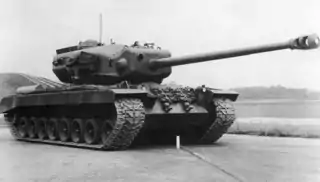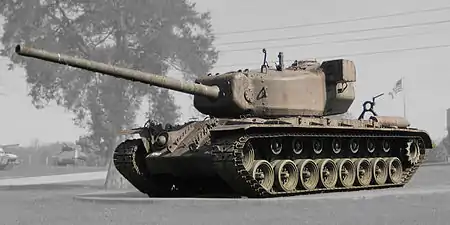T29 Heavy Tank
The Heavy Tank T29 and Heavy Tank T34 were American heavy tanks projects started in March 1944 to counter the appearance of the German Tiger II heavy tank. The T26E3 medium tank (which entered service as the M26 Pershing), weighed around 45 short tons, but was not considered heavily enough armed or armored to counter the Tiger II, which weighed closer to 69 t (76 short tons). The T29 was not ready in time for the war in Europe, but it did provide post-war engineers with opportunities for applying engineering concepts to artillery and automotive components.
| Heavy Tank T29 | |
|---|---|
 T29 Heavy tank in Aberdeen Proving Ground 1945 | |
| Type | Heavy tank |
| Place of origin | United States |
| Service history | |
| In service | Trials only |
| Used by | United States Army |
| Production history | |
| Designed | 1944–1945 |
| Manufacturer | Pressed Steel Car Company Detroit Arsenal |
| No. built | 8 |
| Variants | T29, T29E1, T29E2, and T29E3 |
| Specifications (T29) | |
| Mass | 141,500 lb (64.2 t; 63.2 long tons) combat loaded |
| Length | 37 ft 11.5 in (11.57 m) gun forward 32 ft 9 in (10 m) gun aft |
| Width | 12 ft 5.5 in (3.80 m) over sand shields |
| Height | 10 ft 6 in (3.20 m) over cupola |
| Crew | 6 (driver, commander, gunner, 2 loaders)[1] |
| Armor | hull front 4 in (102 mm) maximum gun shield 11 inches (279 mm) maximum turret front 9 in (249 mm)[1] |
Main armament | 105 mm gun T5E1 (63 rounds) (T29E1, T29E3) 105 mm gun T5E2 (63 rounds) (T29, T29E2) |
Secondary armament | 2 x .50 in (12.7 mm) Browning M2HB machineguns, coaxial 1x .50 M2HB flexible AA (2,420 rounds) 1x .30 Browning M1919A4, bow (2,500 rounds) |
| Engine | 1,649 cubic inch (27 liter) Ford GAC V12[1] gasoline 650 hp (480 kW) net at 2800 rpm |
| Power/weight | 9.2 hp/tonne (net) |
| Transmission | General Motors CD-850-1 crossdrive, three speeds (two forward, one reverse) |
| Suspension | torsion-bar |
| Ground clearance | 18.8 in (48 cm) |
| Fuel capacity | 300 US gallons (1,140 liters) |
Operational range | 100 miles (160 km) |
| Maximum speed | 22 mph (35 km/h) |
Development
The T29 was based upon a lengthened version of the T26E3 chassis and featured heavier armor, an upgraded Ford GAC engine producing about 770 bhp (570 kW) gross, 650 bhp (480 kW) net, more comfortable controls for the driver,[2] and a massive new turret incorporating the high-velocity 105 mm gun T5. It weighed approximately 132,000 lb (60 t; 59 long tons) unstowed and 141,000 lb (64 t; 63 long tons) combat loaded. Its maximum armor thickness was 279 mm[3] compared to 180 mm on the German Tiger II while its 105 mm gun was 7.06 m long[4] (66 calibres, 105L67) compared to the 6.29 m[5] of the Tiger II's 88 mm. (71 calibers long, 88/L71) Other trial models had Allison V1710 V12 engines.[3] The T29 featured a coincidence rangefinder projecting from both sides of the turret, distinctively resembling "ears". The procurement of 1,200 T29s was proposed on 1 March 1945, and revised to 1,152 on 12 April 1945, but by shortly after the end of World War II, only one T29 had been produced, with a second partially completed. In August 1945, the order was cancelled entirely, and it was intended to procure ten T29s for postwar testing. This number was later reduced to eight in July 1947.
Developed at the same time and closely related to the T29, the T30 Heavy Tank was virtually identical, but was mounted with the 155 mm gun T7, featured a more powerful engine, and had an additional crew member to help load the heavy ammunition for the gun. Two vehicles were produced.
The final variation of the T29 concept, the heavy tank T34, mounted a 120 mm gun based upon the then-current 120mm M1 anti-aircraft gun to further increase the armor penetration capability of the T29. This gun was designated as the 120 mm T53, which could achieve a maximum rate of fire of 5 rounds per minute with two loaders.[6] With solid shot weighing 50 lb (23 kg), it had a muzzle velocity of 3,150 ft/s (960 m/s). A lightweight HVAP round with a muzzle velocity of 4,100 ft/s (1,200 m/s) was in development. In order to balance out the weight of the longer and heavier cannon, an additional 101 mm of armour was welded on the rear of the turret bustle.[7] The end of the war curtailed further development, and only two prototypes were built. The experience gained with the T34 was valuable in the development of the M103 heavy tank.
There are several surviving T29s at Fort Benning, Georgia. They are being stored in preparation for an Armor exhibit. One has the distinctive rangefinder, while the other does not. Both can be seen as well as many other vehicles in a fenced enclosure on 25 Infantry Regiment Road. One is located in front of the National Armor and Cavalry Museum.

See also
Tanks of comparable role, performance and era
- M6A2E1 heavy tank - Prototype used for testing T29's armament system
- T32 heavy tank - Prototype with a similar design; uses a 90 mm cannon
- T30 heavy tank - Identical to the T29, but using a 155 mm cannon
- T34 heavy tank - A modernized T30 using a 120 mm cannon
- Tiger II heavy tank - A German heavy tank the T29 was designed to counter
- IS-3 heavy tank - Contemporary Soviet assault tank
- IS-4 heavy tank - Contemporary Soviet heavy tank
- Caernarvon Mark II - British heavy tank
- AMX-50 heavy tank - Prototype French heavy tank series
References
- Hunnicutt, Firepower, p.197.
- Hunnicutt, Firepower, p. 72
- Hunnicutt, Firepower, p.198.
- Hunnicutt, Firepower, p.216. continental length - from rear face of breech to muzzle
- Jentz & Doyle, Kingtiger Heavy Tank 1942-45, p.8.
- Hunnicutt, Firepower, p.217.
- Hunnicutt, Firepower, p.94.